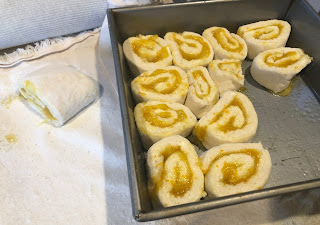
Recipe: No-yeast dough produces a light citrusy treat

|
Rainy or foggy or just overcast, January is usually bleak. Thank goodness for citrus, which brightens up our gardens and our kitchens.
I love to use my navel oranges in baking this time of year, and I'm always on the lookout for different recipes for breakfast treats. This recipe for orange rolls was contributed to Food52.com by Posie Harwood Brien, who says her mother would make it for special-occasion weekend breakfasts.
Making the rolls is not as fast as making muffins or pancakes, so I see why Posie's mom saved it for certain weekends. But the rolls come together pretty quickly, since the ingredient list is short and there's no yeast involved. The dough is like a sweet biscuit, and the orange filling is not tricky. If you've made scones, this will be an easy next step.
And now that I've made this, I'm thinking of other citrus to try with the dough. The orange is straightforward, but combinations could boost the sweet-tart factor. (Notice I added a bit of lime juice to the orange juice, and could have gone with more.) Lemon-lime next, or maybe blood orange-grapefruit? A bit of zest or a spice in the dough also might be fun. Citrus season has several months left, so there's time.

|
Orange breakfast rolls
Adapted from Food52.com
Makes 12-15
Ingredients:
Filling:
6 tablespoons unsalted butter
3 tablespoons unbleached all-purpose flour
2 tablespoons (or more) orange zest, from 2 large oranges
1/3 cup freshly squeezed orange juice (plus a squirt of lime juice if you have any, optional)
1/2 cup granulated sugar
Dough:
3 tablespoons unsalted butter, cut into 1/2-inch chunks and chilled
2 cups unbleached all-purpose flour
1 tablespoon plus 1 teaspoon baking powder
1/2 teaspoon salt
1 cup cold milk, dairy or nondairy
Instructions :
To make the filling, melt the 6 tablespoons butter in a medium saucepan (preferably nonstick) over medium heat. As soon as it is melted, whisk in the 3 tablespoons flour, blending until smooth. Then stir in the orange zest and the juice, cooking until the mixture thickens, 1 or 2 minutes.
Remove the filling from the heat and stir in the sugar until it dissolves. The filling will become more translucent, like lemon curd. Set it aside to cool.
If you haven't already done so, pop the 3 tablespoons of butter, in chunks, into the freezer to chill for a bit.
Preheat the oven to 400 degrees. Prepare a 9-by-9-inch baking pan or 12-cup muffin tin by thoroughly greasing it. (A muffin tin will give you rolls with crispier edges, while the baking pan will produce softer edges on the rolls.)

\Don't worry if the rolls don't quite fill the pan --
they will puff up during bakng. |
To make the dough, measure the flour into a large bowl, and whisk in the baking powder and the salt. Cut the chilled butter into the flour mixture with a pastry blender or two knives, until there are only pea-sized lumps.
Stir the milk into the flour-butter mixture with a fork just until the dough begins to come together. Turn the dough out onto a well-floured cloth or countertop and knead it gently until the dough is smooth. (Some chunks of butter will be visible, but that's normal.)
Roll the dough into a rectangle, about 15 inches by 10 inches and about 1/4-inch thick. Reserve 1/2 cup of the filling, and spread the rest on the rectangle, leaving a narrow strip of uncovered dough on all four sides.
Starting on one long edge, carefully roll the dough into a log. Pinch the seam closed to keep filling from spilling out. Using a serrated knife or piece of unflavored dental floss, cut the log into even slices, 12 for the muffin tin or up to 15 for the baking pan (I wound up with 14).
Place each slice gently into the prepared pan. Bake 18-20 minutes until the tops are consistently golden brown.
Remove from the oven and run a knife around the edge to prevent sticking. Let cool a few minutes, then drizzle with the reserved filling and serve.

|
Comments
0 comments have been posted.Sacramento Digs Gardening to your inbox.
Sites We Like
Garden Checklist for week of July 21
Your garden needs you!
* Keep your vegetable garden watered, mulched and weeded. Water before 8 a.m. to reduce the chance of fungal infection and to conserve moisture.
* Feed vegetable plants bone meal, rock phosphate or other fertilizers high in phosphate to stimulate more blooms and fruiting. (But wait until daily high temperatures drop out of the 100s.)
* Don’t let tomatoes wilt or dry out completely. Give tomatoes a deep watering two to three times a week.
* Harvest vegetables promptly to encourage plants to produce more. Squash especially tends to grow rapidly in hot weather. Keep an eye on zucchini.
* Pinch back chrysanthemums for bushy plants and more flowers in September.
* Remove spent flowers from roses, daylilies and other bloomers as they finish flowering.
* Pinch off blooms from basil so the plant will grow more leaves.
* Cut back lavender after flowering to promote a second bloom.
* It's not too late to add a splash of color. Plant petunias, snapdragons, zinnias and marigolds.
* From seed, plant corn, pumpkins, radishes, winter squash and sunflowers.